论文 (一种新型的自动售货机用取物箱的设计).doc
一种新型的自动售货机用取物箱的设计【15张CAD图纸和说明书】
收藏
资源目录

压缩包内文档预览:(预览前20页/共43页)
编号:6044348
类型:共享资源
大小:3.35MB
格式:ZIP
上传时间:2017-10-30
上传人:俊****计
认证信息
个人认证
束**(实名认证)
江苏
IP属地:江苏
40
积分
- 关 键 词:
-
一种
新型
自动
售货
机用取物箱
设计
15
cad
图纸
以及
说明书
仿单
- 资源描述:
-
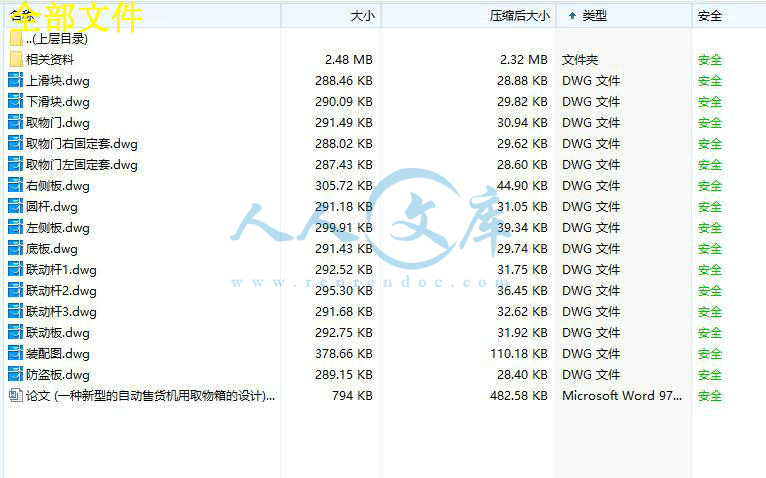




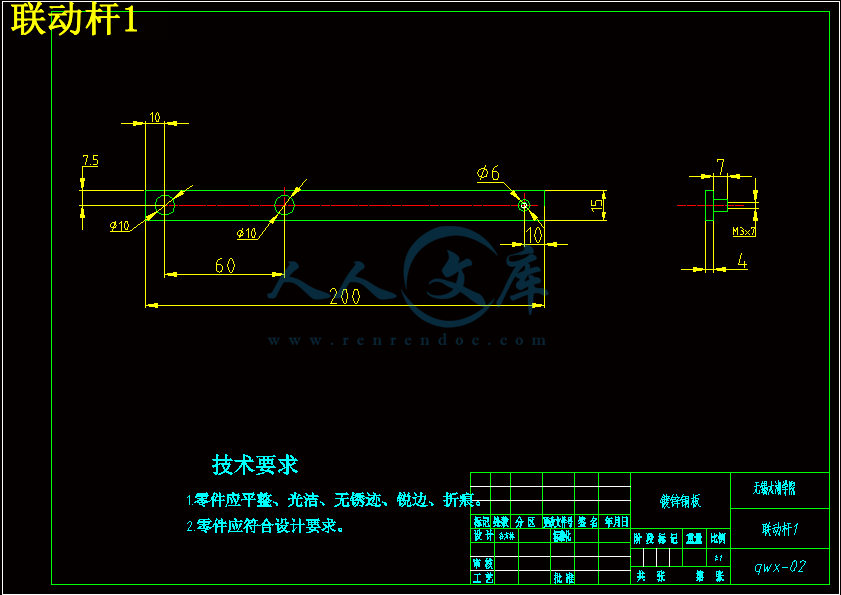
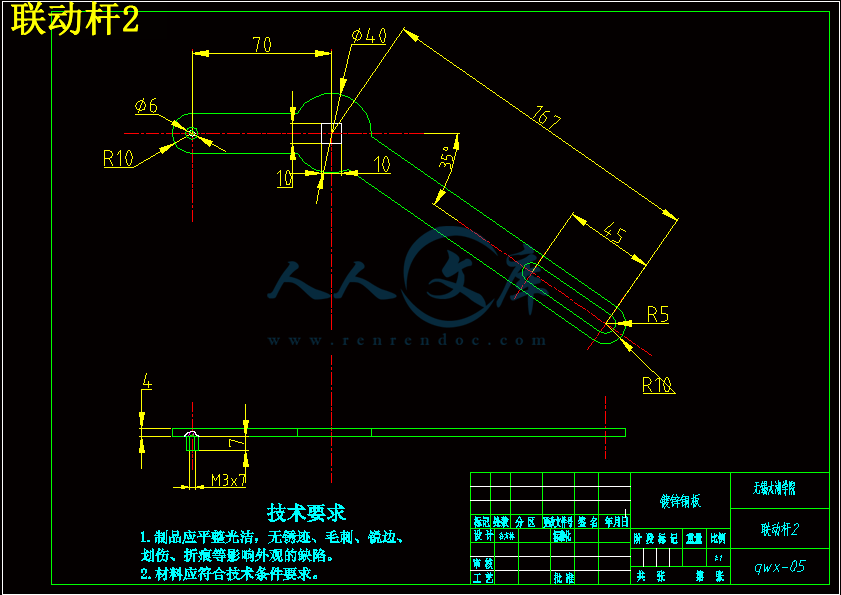

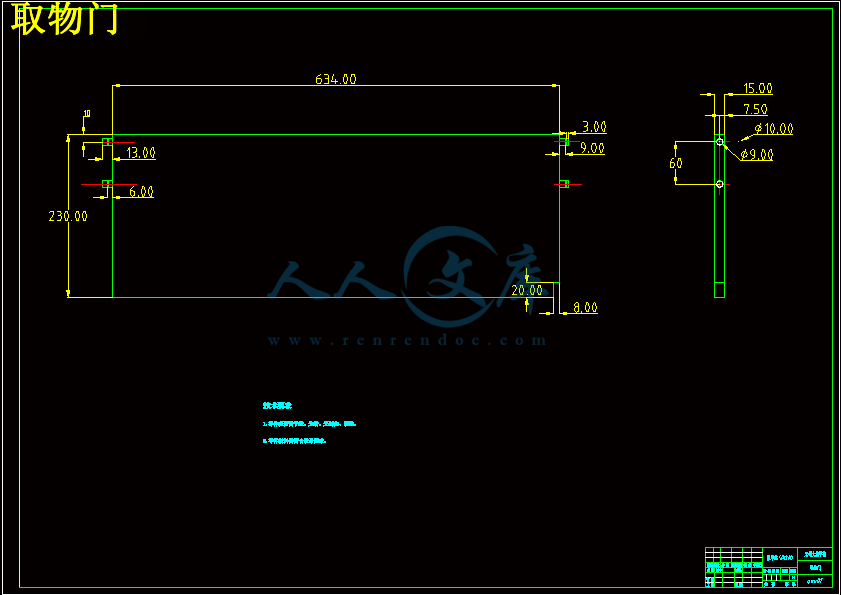





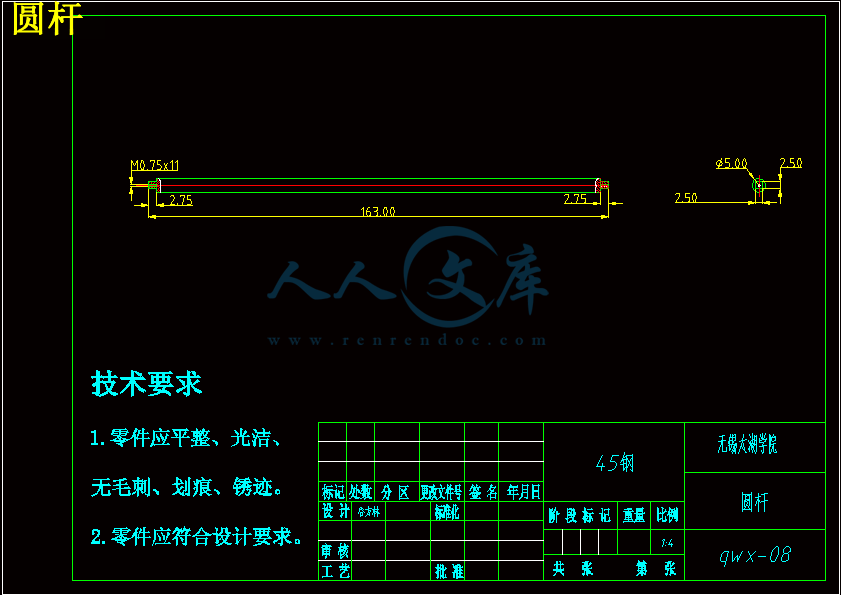


- 内容简介:
-
英文原文Kinematic and dynamic synthesis of a parallel kinematic high speeddrilling machineAbstractTypically, the termhigh speed drilling is related to spindle capability of high cutting speeds. The suggested high speed drilling machine (HSDM) extends this term to include very fast and accurate point-to-point motions. The new HSDM is composed of a planar parallel mechanism with two linear motors as the inputs. The paper is focused on the kinematic and dynamic synthesis of this parallel kinematic machine (PKM). The kinematic synthesis introduces a new methodology of input motion planning for ideal drilling operation and accurate point-to-point positioning. The dynamic synthesis aims at reducing the input power of the PKM using a spring element. Keywords: Parallel kinematic machine; High speed drilling; Kinematic and dynamic synthesis1. IntroductionDuring the recent years, a large variety of PKMs were introduced by research institutes and by industries. Most, but not all, of these machines were based on the well-known Stewart platform 1 configuration. The advantages of these parallel structures are high nominal load to weight ratio, good positional accuracy and a rigid structure 2. The main disadvantages of Stewart type PKMs are the small workspace relative to the overall size of the machine and relatively slow operation speed 3,4. Workspace of a machine tool is defined as the volume where the tip of the tool can move and cut material. The design of a planar Stewart platform was mentioned in 5 as an affordable way of retrofitting non-CNC machines required for plastic moulds machining. The design of the PKM 5 allowed adjustable geometry that could have been optimally reconfigured for any prescribed path. Typically, changing the length of one or more links in a controlled sequence does the adjustment of PKM geometry.The application of the PKMs with constant-length links for the design of machine tools is less common than the type with varying-length links. An excellent example of a constant-length links type of machine is shown in 6. Renault-Automation Comau has built the machine named Urane SX. The HSDM described herein utilizes a parallel mechanism with constant-length links.Drilling operations are well introduced in the literature 7. An extensive experimental study of highspeed drilling operations for the automotive industry is reported in 8. Data was collected fromhundreds controlled drilling experiments in order to specify the parameters required for quality drilling. Ideal drilling motions and guidelines for performing high quality drilling were presented in 9 through theoretical and experimental studies. In the synthesis of the suggested PKM, we follow the suggestions in 9.The detailed mechanical structures of the proposed new PKM were introduced in 10,11. One possible configuration of the machine is shown in Fig. 1; it has large workspace, highspeed point-to-point motion and very high drilling speed. The parallel mechanism provides Y, and Z axes motions. The X axis motion is provided by the table. For achieving highspeed performance, two linear motors are used for driving the mechanism and a highspeed spindle is used for drilling. The purpose of this paper is to describe new kinematic and dynamic synthesis methods that are developed for improving the performance of the machine. Through input motion planning for drilling and point-to-point positioning, the machining error will be reduced and the quality of the finished holes can be greatly improved. By adding a well-tuned spring element to the PKM, the input power can be minimized so that the size the machine and the energy consumption can be reduced. Numerical simulations verify the correctness and effectiveness of the methods presented in this paper.2. Kinematic and dynamic equations of motion of the PKM moduleThe schematic diagram of the PKM module is shown in Fig. 2. In consistent with the machine tool conventions, the z-axis is along the direction of tool movement. The PKM module has two inputs (two linear motors) indicated as part 1 and part 6, and one output motion of the tool. The positioning and drilling motion of the PKM module in this application is characterized by (y axis motion for point-to-point positioning) and (z axis motion for drilling). Motion equations for both rigid body and elastic body PKM module are developed. The rigid body equations are used for the synthesis of input motion planning of drilling and input power reduction. The elastic body equations are used for residual vibration control after point-to-point positioning of the tool.2.1. Equations of motion of the PKM module with rigid linksUsing complex-number representation of mechanisms 12, the kinematic equations of the tool unit (indicated as part 3 which includes the platform, the spindleand the tool) are developed as follows. The displacement of the tool isandwhere b is the distance between point B and point C, r is the length of link AB (the lengths of link AB, CD and CE are equal). The velocity of the tool iswhereThe acceleration of the tool iswhereThe dynamic equations of the PKM module are developed using Lagranges equation of the second kind 13 as shown in Eq. (7).echanism can be derived using the finite element method and take the form ofwhere M, C and K are system mass, damping and stiffness matrix, respectively; D is the set of generalized coordinates representing the translation and rotation deformations at each element node in global coordinate system; R is the set of generalized external forces corresponding to D; n is the number of the generalized coordinates (elastic degrees of freedom of the mechanism). In our FEA model, we use frame element shown in Fig. 3 in which EIe is the bending stiffness (E is the modulus of elasticity of the material, Ie is the moment of inertia), q is the material density, le isthe original length of the element. are nodal displacements expressed in local coordinate system(x, y). The mass matrix and stiffness matrix for the frame element will be 66 symmetric matrices which can be derived fromthe kinetic energy and strain energy expressions as Eqs. (12) and (13)where T is the kinetic energy and U is the strain energy of the element; are the linear 1 2 3 4 5 6 and angular deformations of the node at the element local coordinate system. Detailed derivations can be found in 14. Typically, a compliant mechanism is discretized into many elements as in finite element analysis. Each element is associated with a mass and a stiffness matrix. Each element has its own local coordinate system. We combine the element mass and stiffness matrices of all elements and perform coordinate transformations necessary to transform the element local coordinate systemto global coordinate system. This gives the systemmass M and stiffness K matrices. Capturing the damping characteristics in a compliant systemis not so straightforward. Even though, in many applications, damping may be small but its effect on the systemstability and dynamic response, especially in the resonance region, can be significant. The damping matrix C can be written as a linear combination of the mass and stiffness matrices 15 to form the proportional damping C which is expressed aswhere a and b are two positive coefficients which are usually determined by experiment. An alternate method 16 of representing the damping matrix is expressing CasThe element of C is defined as ,where signKij=(Kij/|Kij|), Kij and Mij are the elements of K and M, is the damping ratio of the material.The generalized force in a frame element is defined aswhere Fj and Mj are the jth external force and moment including the inertia force and moment on the element acting at (xj ,yj), and m is the number of the externalforces acting on the element. The element generalized forces,are then combined to formthe systemgeneralized force R. The second order ordinary differential equations of motion of the system, Eq. (11), can be directly integrated with a numerical method such as Runge-Kutta method. For the PKM we studied, each link was discreted as 15 frame elements. Both Matlab and ADAMS software are used for programming and solving these equations.3. Input motion planning for drillingSuppose we know the ideal motion function of the drilling tool. How to determine the input motor motion so that the ideal tool motion can be realized is critical for high quality drillings. The created explicit input motion function also provides the necessary information for machine controls. According to the study done in 9, the drilling process can be divided into three phases: entrance phase, middle phase, and exit phase. In order to increase the productivity and quality of the drilling, many operation constraints such as minimum tool life constraint, hole location error constraint, exit burr constraint, drill torsion breakage constraint, etc. must be considered and satisfied. Under these conditions, the feed velocity of the tool should be slow at the entrance phase to reduce the hole location errors. The tool velocity should also be slow at the exit phase to reduce the exit burr. At the middle phase, the tool drilling velocity should be fast and kept constant. The retraction of the tool after finishing the drilling should be done as quickly as possible to increase the productivity. Based on these considerations, we assume that the ideal drilling and retracting velocities of the tool are given by Eq. (17).where vT1 is the maximum drilling velocity, T1, T2,and T3 are the times corresponding to the entrance phase, the middle phase and the exit phase. vT2 is the maximum retracting velocity. T4, T5, and T6 are corresponding to accelerating, constant velocity, and decelerating times for retracting operation. is the cycle time for a single drilling. As a numerical example, suppose we drill a 25.4 mm (1 in) deep hole with Tc=0.4s, 0.3s for drilling, 0.1s for retracting. Set T1=T3 0.06s, T4=T6=0.03s. Under these con-ditions, vT1=106(mm/s), vT2=-363(mm/s). The graphical expression of the ideal tool motion is shown in Fig. 4. If the link length in PKM r=500 mm, the angle=53 at the starting point of drilling, the corresponding input motor velocity relative to the idealtool motion is shown in Fig. 5. Generally, the curve fitting method can be used to create the input motion function. But according to the shape of the curve shown in Fig. 5, we create the linear motor velocity function manually section by section as shown in Eq. (18).where vB=143.48mm/s, vC=165.77mm/s, vE=-557.36mm/s, vF=-499.44mm/s. When plotting the velocity curve with Eq. (18), no visual difference can be found with the curve shown in Fig. 5. Eq. (18) is composed of six parts with four cycloidal functions and two linear functions. If we control the two linear motors to have the same motion as described in Eq. (18), the drilling and retracting velocity of the tool will be almost the same as shown in Fig. 4. The absolute errors between the ideal and real tool velocity are shown in Fig. 6, in which the maximum error is less than 8 mm/s, the relative error is less than 1.5%. At the start and the end positions of the drilling, the errors are zero. These small absolute and relative errors illustrate the created input motion and are quite acceptable. The derived function is simple enough to be integrated into the control algorithmof the PKM.4. Input motion planning for point-to-point positioningIn order to achieve fast and accurate positioning operation in the whole drilling process, the input motion should be appropriately planned so that the residual vibration of the tool tip can be minimized. Conventionally the constant acceleration motion function is commonly used for driving the axes motions in machine tools. Although this kind of motion function is simple to be controlled, it may excite the elastic vibration of the systemdue to the sudden changes in acceleration. Take the same PKM module used in previous for example. A FEA model is built using ADMAS with frame elements. The positioning motion is the y-axis motion, which isrealized by the two linear motors moving in the same direction. Suppose the positioning distance between the two holes is 75mm, the constant acceleration is 3g(approximated as 30m/s here). The input motion of the linear motors with constant acceleration and deceleration is shown in Fig. 7, in which the maximum velocity is 1500 mm/s, the positioning time is 0.1 s. Assuming the material damping ratio as 0.01, the residual vibration of the tool tip is shown in Fig. 8. In order to reduce the residual vibration and make the positioning motion smoother, a six order polynomial input motion function is built as Eq. (19)where the coeffcients ci are the design variables which have to be determined by minimizing the residual vibration of the tool tip. Selecting the boundary conditions as that when t=0, sin=0, vin=0, ain=0;and when t=Tp, sin=h, vin=0, ain=0, where Tp is the point-to-point positioning time, the first six coeffcients are resulted:Logically, set the optimization objective aswhere c6 is the independent design variable; is the maximum fluctuation of residual vibrations of the tool tip after the point-to-point positioning. Set and start the calculation from c6=0. The optimization results in c6=-10mm/s . Consequently, c5=7.510mm/s , c4 =-1.42510mm/s , c3=8.510mm/s , c2=c1=c0=0. It can be seen that the optimization calculation brought the design variable c6 to the boundary. If further loosing the limit for c6, the objective will continue reduce in value, but the maximum value of acceleration of the input motion will become too big. The optimal input motions after the optimization are shown in Fig. 9. The corresponding residual vibration of the tool tip is shown in Fig. 10. It is seen from comparing Fig. 8 and Fig. 10 that the amplitude and tool tip residual vibration was reduced by 30 times after optimization. Smaller residual vibration will be very useful for increasing the positioning accuracy. It should be mentioned that only link elasticity is included in above calculation. The residual vibration after optimization will still be very small if the compliance from other sources such as bearings and drive systems caused it 10 times higher than the result shown in Fig. 10.5. Input power reduction by adding spring elementsReducing the input power is one of many considerations in machine tool design. For the PKM we studied, two linear motors are the input units which drive the PKM module to perform drilling and positioning operations. One factor to be considered in selecting a linear motor is its maximum required power. The input power of the PKM module is determined by the input forces multiplying the input velocities of the two linear motors. Omitting the friction in the joints, the input forces are determined from balancing the drilling force and inertia forces of the links and the spindle unit. Adding an energy storage element such as a spring to the PKM may be possible to reduce the input power if the stiffness and the initial (free) length of the spring are selected properly. The reduction of the maximum input power results in smaller linear motors to drive the PKM module. This will in turn reduce the energy consumption and the size of the machine structure. A linear spring can be added in the middle of the two links as shown in Fig. 11(a). Or two torsional springs can be added at points B and C as shown in Fig. 11(b). The synthesis process is the same for the linear or torsional springs. We will take the linear spring as an example to illustrate the design process. The generalized force in Eq. (10) has the form ofwhere l0 and k are the initial length and the stiffness of the linear spring. The input power of the linear motors is determined byIn order to reduce the input power, we set the optimization objective as follows:where v is a vector of design variables including the length and the stiffness of the spring, . For the PKM module we studied, the mass properties are listed in Table 1. The initial values of the design variables are set as . The domains for design variables are set as lmin;lmax=400, 500 mm, kmin; kmax=1,20 N/mm. The PKM module is driven by the input motion function described as Eq. (18). Through minimizing objective (24), the optimal spring parameters are obtained as and k=14.99 N/mm. The input powers of the linear motors with and without the optimized spring are shown in Fig. 12, in which the solid lines represents the input power without spring, the dotted lines represents the input power with the optimal spring. It can be seen from the result that the maximum input power of the right linear motor is reduced from 122.37 to 70.43 W. A 42.45% reduction is achieved. For the left linear motor, the maximum input power is reduced from 114.44 to 62.72 W. A 45.19% reduction is achieved. The effectiveness of the presented method by adding a spring element to reduce the input power of the machine is verified. Torsional springs may be sued to reduce the inertial effect and the size of the spring attachment.6. ConclusionsThe paper presents a new type of high speed drilling machine based on a planar PKM module. The study introduces synthesis technology for planning the desirable motion functions of the PKM. The method allows both the point-to-point positioning motion and the up-and-down motion required for drilling operations. The result has shown that it is possible to reduce substantially the residual vibration of the tool tip by optimizing a polynomial motion function. Reducing residual vibration is critical when tool positioning requirement for the HSDM is in the range of several microns. By adding a well-tuned optimal spring to the structure, it was possible to reduce the required input power for driving the line
- 温馨提示:
1: 本站所有资源如无特殊说明,都需要本地电脑安装OFFICE2007和PDF阅读器。图纸软件为CAD,CAXA,PROE,UG,SolidWorks等.压缩文件请下载最新的WinRAR软件解压。
2: 本站的文档不包含任何第三方提供的附件图纸等,如果需要附件,请联系上传者。文件的所有权益归上传用户所有。
3.本站RAR压缩包中若带图纸,网页内容里面会有图纸预览,若没有图纸预览就没有图纸。
4. 未经权益所有人同意不得将文件中的内容挪作商业或盈利用途。
5. 人人文库网仅提供信息存储空间,仅对用户上传内容的表现方式做保护处理,对用户上传分享的文档内容本身不做任何修改或编辑,并不能对任何下载内容负责。
6. 下载文件中如有侵权或不适当内容,请与我们联系,我们立即纠正。
7. 本站不保证下载资源的准确性、安全性和完整性, 同时也不承担用户因使用这些下载资源对自己和他人造成任何形式的伤害或损失。

人人文库网所有资源均是用户自行上传分享,仅供网友学习交流,未经上传用户书面授权,请勿作他用。
|
2:不支持迅雷下载,请使用浏览器下载
3:不支持QQ浏览器下载,请用其他浏览器
4:下载后的文档和图纸-无水印
5:文档经过压缩,下载后原文更清晰
|
 川公网安备: 51019002004831号
川公网安备: 51019002004831号